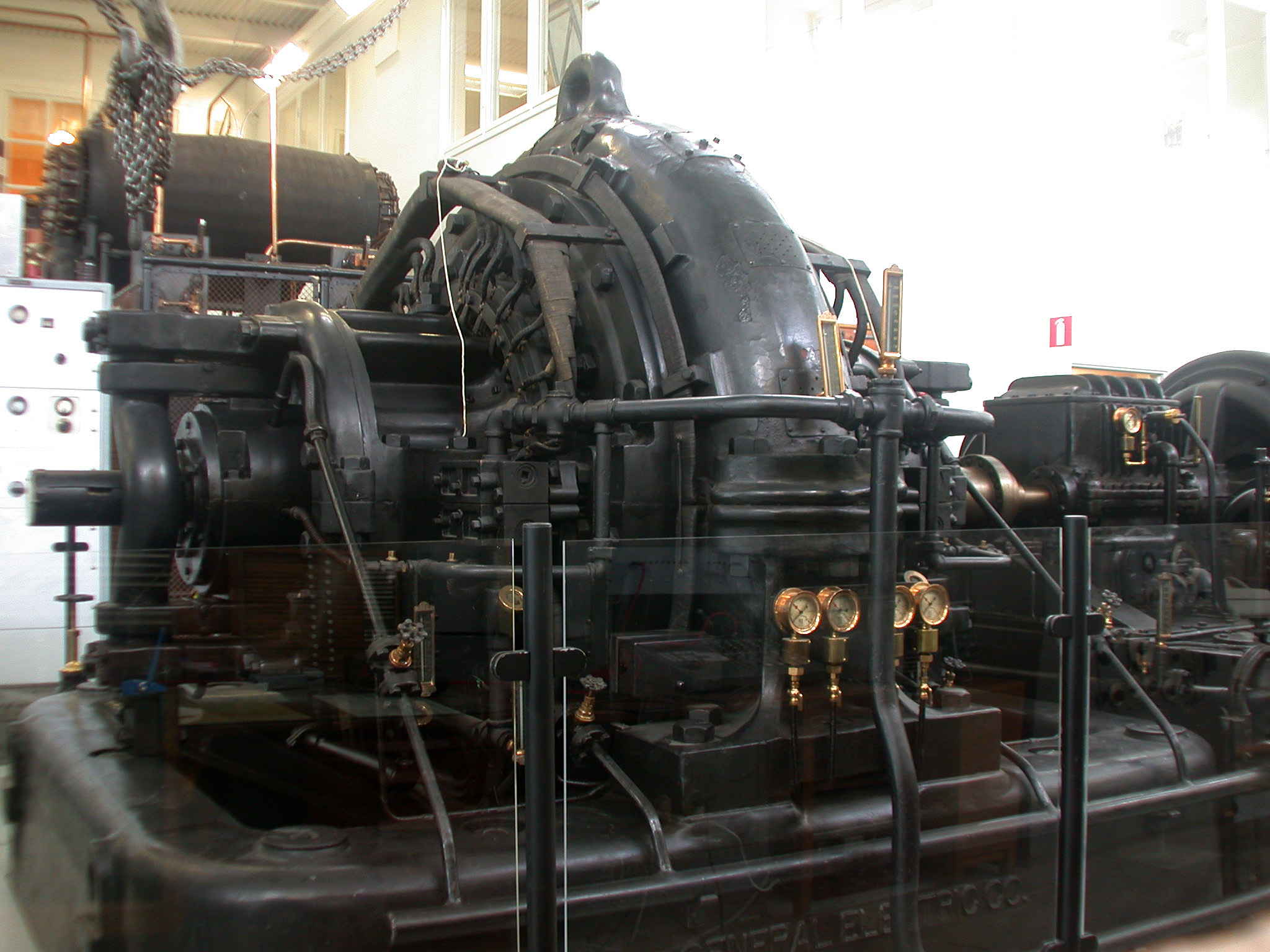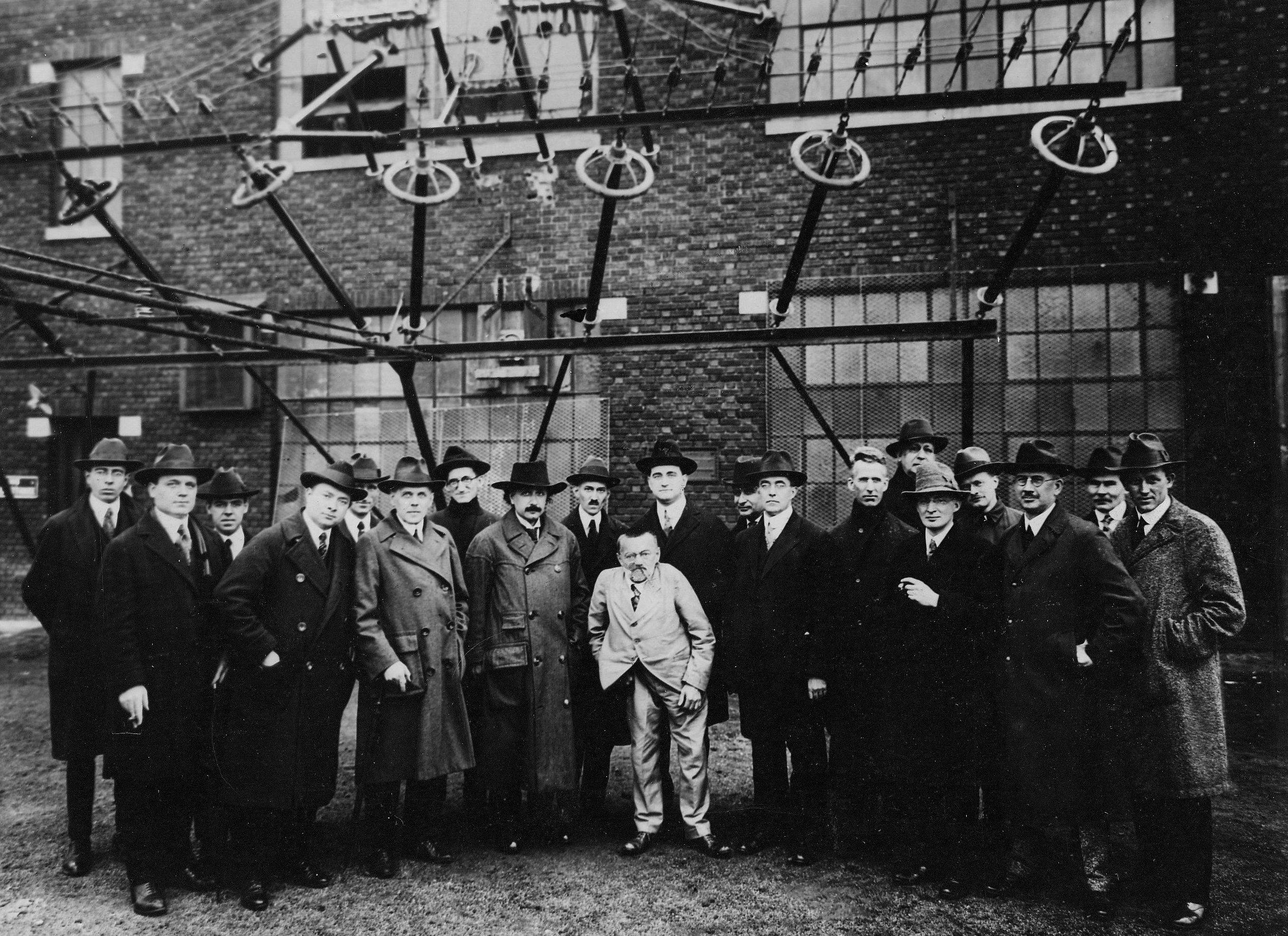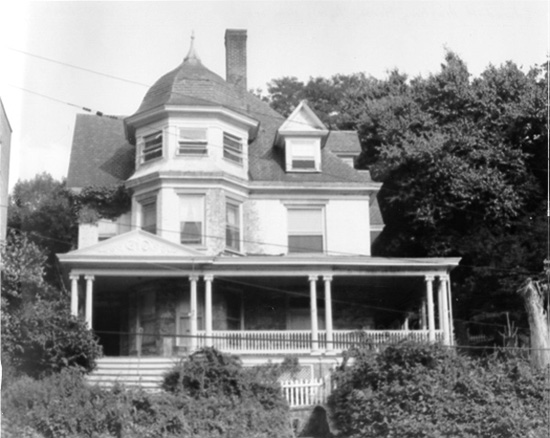|
Frank Conrad
Frank Conrad (May 4, 1874 – December 10, 1941) was an electrical engineer, best known for radio development, including his work as a pioneer broadcaster. He worked for the Westinghouse Electrical and Manufacturing Company in East Pittsburgh, Pennsylvania for half a century. His experimental radio station provided the inspiration, and he acted in an advisory role, for the establishment of Westinghouse's first broadcasting service, over radio station KDKA. Early life Conrad was born May 4, 1874 in Pittsburgh, Pennsylvania, the son of Herbert M. Conrad, a railroad mechanic, and Sadie Conrad. His formal education ended with 7th grade, however in 1928 his work would be recognized with an honorary Doctor of Science degree from the University of Pittsburgh. He began employment at the Westinghouse Electrical and Manufacturing Company at age 16, and at 23 began working in Westinghouse's Testing Department, where he and another engineer, H. P. Davis, developed the first circular-type w ... [...More Info...] [...Related Items...] OR: [Wikipedia] [Google] [Baidu] |
Pittsburgh, Pennsylvania
Pittsburgh ( ) is a city in the Commonwealth (U.S. state), Commonwealth of Pennsylvania, United States, and the county seat of Allegheny County, Pennsylvania, Allegheny County. It is the most populous city in both Allegheny County and Western Pennsylvania, the List of municipalities in Pennsylvania#Municipalities, second-most populous city in Pennsylvania behind Philadelphia, and the List of United States cities by population, 68th-largest city in the U.S. with a population of 302,971 as of the 2020 United States census, 2020 census. The city anchors the Pittsburgh metropolitan area of Western Pennsylvania; its population of 2.37 million is the largest in both the Ohio Valley and Appalachia, the Pennsylvania metropolitan areas, second-largest in Pennsylvania, and the List of metropolitan statistical areas, 27th-largest in the U.S. It is the principal city of the greater Pittsburgh–New Castle–Weirton combined statistical area that extends into Ohio and West Virginia. Pitts ... [...More Info...] [...Related Items...] OR: [Wikipedia] [Google] [Baidu] |
Phonograph
A phonograph, in its later forms also called a gramophone (as a trademark since 1887, as a generic name in the UK since 1910) or since the 1940s called a record player, or more recently a turntable, is a device for the mechanical and analogue recording and reproduction of sound. The sound vibration waveforms are recorded as corresponding physical deviations of a spiral groove engraved, etched, incised, or impressed into the surface of a rotating cylinder or disc, called a "record". To recreate the sound, the surface is similarly rotated while a playback stylus traces the groove and is therefore vibrated by it, very faintly reproducing the recorded sound. In early acoustic phonographs, the stylus vibrated a diaphragm which produced sound waves which were coupled to the open air through a flaring horn, or directly to the listener's ears through stethoscope-type earphones. The phonograph was invented in 1877 by Thomas Edison. Alexander Graham Bell's Volta Laboratory made s ... [...More Info...] [...Related Items...] OR: [Wikipedia] [Google] [Baidu] |
Edison Medal
The IEEE Edison Medal is presented by the Institute of Electrical and Electronics Engineers (IEEE) "for a career of meritorious achievement in electrical science, electrical engineering, or the electrical arts." It is the oldest medal in this field of engineering. The award consists of a gold medal, bronze replica, small gold replica, certificate, and honorarium. The medal may only be awarded to a new leap/breakthrough in the technological area of science. Background The Edison Medal, named after the inventor and entrepreneur Thomas Edison, was created on 11 February 1904 by a group of Edison's friends and associates. Four years later the American Institute of Electrical Engineers (AIEE) entered into an agreement with the group to present the medal as its highest award. The first medal was presented in 1909 to Elihu Thomson. Other recipients of the Edison Medal include George Westinghouse, Alexander Graham Bell, Nikola Tesla, Michael I. Pupin, Robert A. Millikan (Nobel Pri ... [...More Info...] [...Related Items...] OR: [Wikipedia] [Google] [Baidu] |
8XK KDKA
8XK may refer to: * Former experimental radio station established in Wilkinsburg, Pennsylvania in 1916 by Frank Conrad and deleted in 1924. * Former Westinghouse shortwave radio station in East Pittsburgh, Pennsylvania, which changed its call sign from 8XAU in 1924. {{call sign disambiguation ... [...More Info...] [...Related Items...] OR: [Wikipedia] [Google] [Baidu] |
Alexanderson Alternator
An Alexanderson alternator is a rotating machine invented by Ernst Alexanderson in 1904 for the generation of high-frequency alternating current for use as a radio transmitter. It was one of the first devices capable of generating the continuous radio waves needed for transmission of amplitude modulated signals by radio. It was used from about 1910 in a few "superpower" longwave radiotelegraphy stations to transmit transoceanic message traffic by Morse code to similar stations all over the world. Although superceded in the early 1920s by the development of vacuum-tube transmitters, the Alexanderson alternator continued to be used until World War II. It is on the list of IEEE Milestones as a key achievement in electrical engineering. History Prior developments After radio waves were discovered in 1887, the first generation of radio transmitters, the spark gap transmitters, produced strings of ''damped waves'', pulses of radio waves which died out to zero quickly. By the ... [...More Info...] [...Related Items...] OR: [Wikipedia] [Google] [Baidu] |
Longwave
In radio, longwave, long wave or long-wave, and commonly abbreviated LW, refers to parts of the radio spectrum with wavelengths longer than what was originally called the medium-wave broadcasting band. The term is historic, dating from the early 20th century, when the radio spectrum was considered to consist of longwave (LW), medium-wave (MW), and short-wave (SW) radio bands. Most modern radio systems and devices use wavelengths which would then have been considered 'ultra-short'. In contemporary usage, the term ''longwave'' is not defined precisely, and its intended meaning varies. It may be used for radio wavelengths longer than 1,000 m i.e. frequencies up to 300 kilohertz (kHz), including the International Telecommunication Union's (ITU's) low frequency (LF, 30–300 kHz) and very low frequency (VLF, 3–30 kHz) bands. Sometimes the upper limit is taken to be higher than 300 kHz, but not above the start of the medium wave broadcast band at 520&nb ... [...More Info...] [...Related Items...] OR: [Wikipedia] [Google] [Baidu] |
David Sarnoff
David Sarnoff (February 27, 1891 – December 12, 1971) was an American businessman and pioneer of American radio and television. Throughout most of his career, he led the Radio Corporation of America (RCA) in various capacities from shortly after its founding in 1919 until his retirement in 1970. He ruled over an ever-growing telecommunications and media empire that included both RCA and NBC, and became one of the largest companies in the world. Named a Reserve Brigadier General of the Signal Corps in 1945, Sarnoff thereafter was widely known as "The General." Sarnoff is credited with ''Sarnoff's law'', which states that the value of a broadcast network is proportional to the number of viewers. Early life and career David Sarnoff was born to a Jewish family in Uzlyany, a small town in the Russian Empire, now part of Belarus, the son of Abraham Sarnoff and Leah Privin. Abraham emigrated to the United States and raised funds to bring the family. Sarnoff spent much of his early c ... [...More Info...] [...Related Items...] OR: [Wikipedia] [Google] [Baidu] |
Shortwave Radio
Shortwave radio is radio transmission using shortwave (SW) radio frequencies. There is no official definition of the band, but the range always includes all of the high frequency band (HF), which extends from 3 to 30 MHz (100 to 10 metres); above the medium frequency band (MF), to the bottom of the VHF band. Radio waves in the shortwave band can be reflected or refracted from a layer of electrically charged atoms in the atmosphere called the ionosphere. Therefore, short waves directed at an angle into the sky can be reflected back to Earth at great distances, beyond the horizon. This is called skywave or "skip" propagation. Thus shortwave radio can be used for communication over very long distances, in contrast to radio waves of higher frequency, which travel in straight lines ( line-of-sight propagation) and are limited by the visual horizon, about 64 km (40 miles). Shortwave broadcasts of radio programs played an important role in the early days of radi ... [...More Info...] [...Related Items...] OR: [Wikipedia] [Google] [Baidu] |
Edwin Howard Armstrong
Edwin Howard Armstrong (December 18, 1890 – February 1, 1954) was an American electrical engineer and inventor, who developed FM (frequency modulation) radio and the superheterodyne receiver system. He held 42 patents and received numerous awards, including the first Medal of Honor awarded by the Institute of Radio Engineers (now IEEE), the French Legion of Honor, the 1941 Franklin Medal and the 1942 Edison Medal. He was inducted into the National Inventors Hall of Fame and included in the International Telecommunication Union's roster of great inventors. Armstrong attended Columbia University, and served as a professor there for most of his life. Early life Armstrong was born in the Chelsea district of New York City, the oldest of John and Emily (née Smith) Armstrong's three children. His father began working at a young age at the American branch of the Oxford University Press, which published bibles and standard classical works, eventually advancing to the position of ... [...More Info...] [...Related Items...] OR: [Wikipedia] [Google] [Baidu] |
Joseph Horne Company
The Joseph Horne Company, often referred to simply as Joseph Horne's or Horne's, was an iconic, regional department store chain based in Pittsburgh, Pennsylvania. The store was one of the oldest in the country being founded on February 22, 1849, but was often overlooked as it maintained only a regional presence. The chain ceased operations in 1994 after being merged with the Lazarus division of Federated Department Stores. Founders Joseph Horne (1826–1892) was born in Bedford County, Pennsylvania, the son of John Horn and Catherine Otto, grandson of Henry Horn, who had served in the Continental Army. Joseph moved three counties west to Pittsburgh and found his first job in the retail trade with Christian Yeager, the father of South Fork Fishing and Hunting Club member H. C. Yeager. Soon, Joseph moved to the F.H. Eaton store, and became a partner. He bought the business in 1849, at age 23, renaming it The Joseph Horne Company. He joined forces with Christian B. Shea and A. P. ... [...More Info...] [...Related Items...] OR: [Wikipedia] [Google] [Baidu] |
National Institute Of Standards And Technology
The National Institute of Standards and Technology (NIST) is an agency of the United States Department of Commerce whose mission is to promote American innovation and industrial competitiveness. NIST's activities are organized into physical science laboratory programs that include nanoscale science and technology, engineering, information technology, neutron research, material measurement, and physical measurement. From 1901 to 1988, the agency was named the National Bureau of Standards. History Background The Articles of Confederation, ratified by the colonies in 1781, provided: The United States in Congress assembled shall also have the sole and exclusive right and power of regulating the alloy and value of coin struck by their own authority, or by that of the respective states—fixing the standards of weights and measures throughout the United States. Article 1, section 8, of the Constitution of the United States, ratified in 1789, granted these powers to the new Congr ... [...More Info...] [...Related Items...] OR: [Wikipedia] [Google] [Baidu] |





.jpg)
